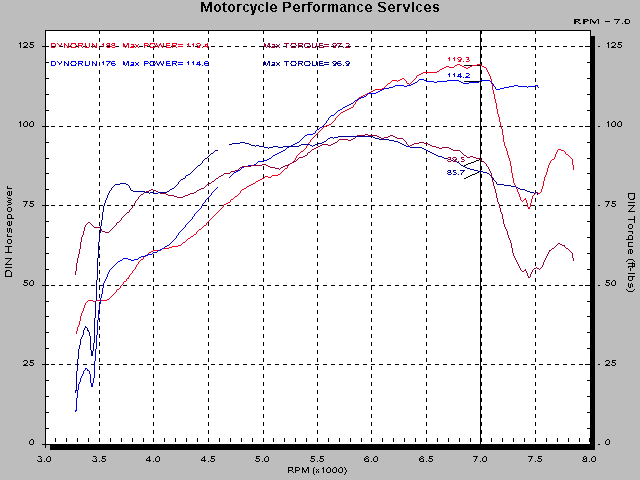
Stage X of Buell Abuse
Michael took the engine apart and cut a bunch of weight off the flywheels, added an oil scraper and sump mods, a late style oil pump to scavenge from the timing chest, and Andrews 0.650" lift inlet cams (Dynomation said that the engine didn't need 0.650" lift at the exhaust .) As well as taking a little more off the head gasket surface, to tighten up the squish clearance.
He was optimistic that the engine would make a lot more than the previous version. Although everything he was doing seemed like it should help, I couldn't help but wonder how we were going to get much more out of a 1205cc engine that already makes 114HP.
The chart below shows run number 176 (which was the last 'hot' run we did before we cooled it off and really went for the best number we could get) compared with one of the early runs after the improvements.

Later in our testing on May 18th (runs 180 thru 227) we figured that the drastic drop in torque above 7000RPM was probably due to valve float. At the time, since the lifters didn't 'pump-up' and they didn't collapse, there was no indication that anything was amiss. However, every time we tried to get a power check above 7000RPM we got the identical indication.
As the test numbers piled up and we had a more difficult time getting repeatable results, we finally gave up and Michael went home.
When Michael tried to check the ignition timing, he found that there was, virtually, no compression. The inlet valves were toasted. The .650" lift cams with the extra rocker-arm ratio had caused the valves to float and we had allowed them to float too many times.
New inlet valves, stock (1.6:1) rockers, and more valve spring seat pressure was added, and the bike fired up just before we went out to the dyno shoot-out at Delano Motorsports. Michael and I were both bummed out by the fact that we didn't have the time to run it on my dyno. We had seen so much variation in carb calibration with each change that we had little faith that it would run properly after so many things were changed.
The Delano shoot-out went fairly well. We had the highest HP H-D and the second highest (Rowdy's 3 13/16" X 3 13/16" M2.)
OK, so that went well.
On June 5th Michael brought it over for one more session before we go to the Buell Homecoming.
Once more we had to solder holes in the emulsion tubes and re-drill soldered-up ones. The calibration of the carbs on this thing is really weird. The intermediate circuit (pilot circuit, on any other carb) needs to be extended to higher throttle angles and uses a fairly large jet size, while the main circuit uses very small jets and tends to run rich at lower RPM (at WOT).
The entire last dyno session went extremely well (runs 228 to 247.) It's amazing how much you can learn when you aren't grinding the subject vehicle into dust.
We got to compare Michael's modified Ducati muffler (thanks Reed) with the Super-Trapp that we had used for much (but not all) of the previous testing. On the first dyno chart on this page, you might notice that the two torque curves are quite different. The older test used the Super-Trapp which pushes up the 4800 RPM torque hump and shifts the whole curve down a little. With repeatable back-to-back testing we got a good comparison. Below;
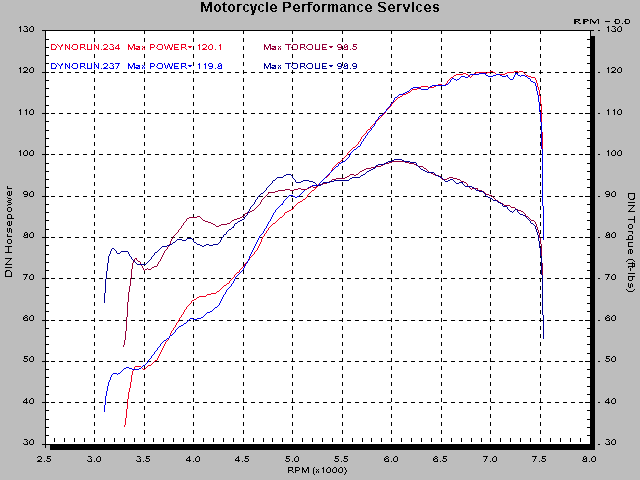
The largest difference between the two mufflers occurs at 4000 and 5000 RPM. With the Super-Trapp (the blue trace) the bike tends to loft the front wheel as it goes from 4300 to 5000 RPM due to the 22% increase in torque over 700 RPM.
We liked Michael's homebuilt because there appears to be a little more stabile at the top-end (and, after all, this is about top-end) and the low-end was a little less abrupt. Plus, there is the fact that we can say that all of the stuff on the bike was done by Michael.
Since we were getting such repeatable testing we decided to do another timing test. We were pretty sure that the timing was almost right, but Michael thought that the flattening at the top of the power band might be a sign of insufficient spark lead.
The chart below shows the result of 2 degrees more ignition advance. (The red trace.)
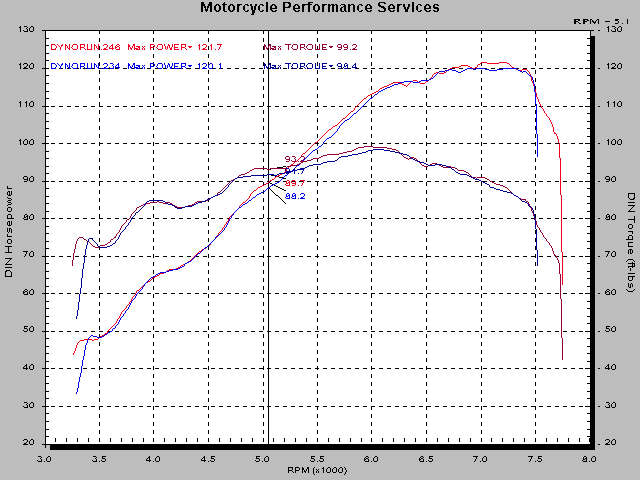
Finally, we have the smoothest most repeatable power curves we've had so far and the numbers aren't too bad either.
We have found that the Sportster engine makes better power in 5th gear (the lower acceleration rate of the engine means that the drive-train is absorbing less and it shows on an inertia dyno.) For some reason the Evos loose power in top gear. What's up wi' that? Maybe the acceleration of the rear wheel is so great that it absorbs a bunch of power?
For a final run, I ran it in 5th gear, below.
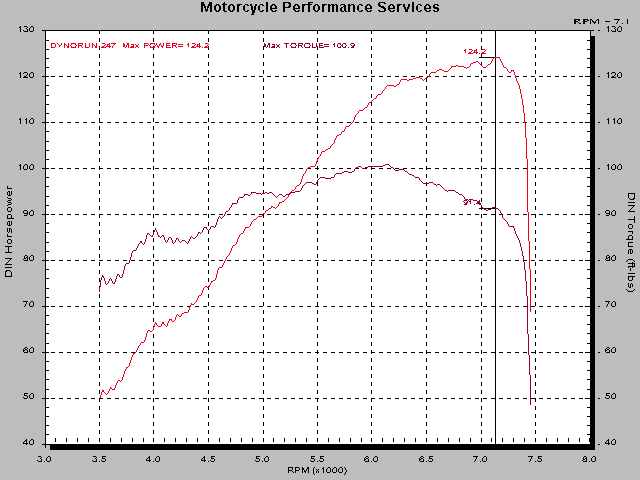
The DIN correction factor makes it look pretty good, but now we can say that the we have over 120HP even with the SAE correction. All of the last series of testing was done using Amoco Ultimate 92 octane 'pump' gas.
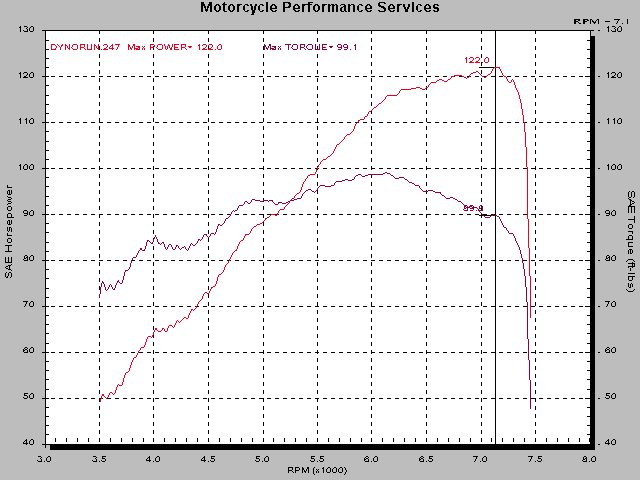
That should go over pretty well at the Buell dyno shoot-out at Hal's on Friday after-noon. We plan on being there, if you've read this, and are in attendance let me know.
This bike runs like a real 'sport-bike' now. For kicks, I over-layed one of the 4th gear runs on a 4th gear run of a 955cc Ducati that I built. It has a 51mm full system, and 916 SPS cams. How do you think these would compare in a 4th gear roll-on?

We made it to Hal's on Friday just after noon, perfect timing to get ready for the dyno 'shoot-out'.
Michael's S2 was entered early, number 17. It was interesting to watch the spectators back up as the dyno operator revved it to 7000RPM (at Mike's request.)
The dyno at Hal's is quite old and the drum is getting pretty smooth. I thought I saw a wisp of tire smoke as it was run up, so I wasn't surprised when the power number was lower than we get on my dyno. However, 112.2HP isn't too bad. Considering that it was entered in the modified S1,S2 class, the number looked real good. (The person entering the numbers on the board, first entered it under the 'big-bore' class.)
There was one bike in the same class, that I was a little concerned about. That one was a stock engine with nitrous-oxide injection. Unfortunately for the owner, the nitrous oxide failed to flow and the exhaust puffed a sooty puff as the extra fuel went through.
Finally, near the end of the evening, S&S entered their 100CI 'Corporate jet' and beat us for the overall high horse-power award, by..... 0.3HP!?!!!
So, a class win and second overall is pretty good for a stock displacement, pump gas, street bike.
What's next? Saddle-bags!!!!!